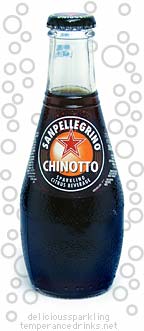Sanpellegrino Chinotto
200 mL bottle 3.69 g sugar / oz.
|
History The Sanpellegrino spring in Bergamo in the Italian Alps has been known since at least the twelfth century. Legendarily, Leonardo da Vinci even visited to sample the waters in 1509. An opulent bath house was built at the spring in 1840, and in 1906 a grand spa hotel and casino established Sanpellegrino as a playful vacation spot for aristocrats and wealthy patients who came to relax and recover from the ailments of modern life, at least for a time. The Sanpellegrino company was founded in 1899 to bottle the mineral waters from the spring with a little carbonation added artificially to help preserve the freshness of the water in its long journey shipped to locations all over the world. From its first year the water has been sold locally and internationally. In 1932, Sanpellegrino introduced the Aranciata soda made from mineral water with added sugar and flavoring made from concentrated orange juice. Aranciata Arama, a bitter citrus drink, was added in 1949 and then the additional flavors of Chinotto and Limonata a year later. Since the early 1970s the flavored Sanpellegrino drinks are no longer made using mineral water from the Sanpellegrino spring, unlike other brands such as Uludag or Quintuples. Chinotto is a small citrus fruit grown near the Mediterranean which has a bitter flavor. While the name refers to a possible origin in China, it is likely that the bitter flavor developed from a mutation in Italy. Traditionally the fruits are preserved with sugar as a candied fruit or the peels used as a flavoring in bitter liquers such as Campari. In 1949, businessman Pietro Nieri created a soda flavored with the fruit known as Chinotto Neri, or Chin8. Sanpellegrino launched its Chinotto a year later. In 1954, Chinotto Recoaro was created, which grew to become the most popular in the 1950s and 60s with the slogan "the other way to drink dark," implying a local alternative to that other dark soda, the foreign Coca-Cola then sweeping across post-war Europe. In recent years Chinotto has become more popular as a unique local flavor championed by the Italian Slow Food Movement. Cultivation of chinotto trees declined along with consumption of candied fruit in the early twentieth century, but the drink's revival has spurred efforts to replant the trees as well. In 1997 Sanpellegrino was purchased by the multinational food conglomerate Nestlé. Sanpellegrino continues to expand around the world. Since 2001 more flavors such as Aranciata Rossa have been added. In 2010, Sanpellegrino produced over 1 billion bottles of mineral water and flavored sodas. Review That first sip is always a strange surprise and disappointment of expectations: this drink is so different from most sodas. It is more bitter than a Moxie, but similar in attitude. Its not too carbonated, but the bitter herbal medicinal flavor is refreshing and stimulating all by itself. Keep sipping it and the bitter taste grows on you. Its a powerful flavor, it lingers on the tongue like a sharp radish or bitter lettuce long after you've swallowed. But too soon the bottle is gone. By the end it seems like the best flavor that ever existed. Its that same flavor in a pungent grapefruit juice that just makes you crave more immediately after you've finished a glass. I want another!
Ingredients Carbonated water, high fructose corn syrup, sugar, caramel color, citric acid, chinotto extract, sodium citrate, salt, L-ascorbic acid. Made by Sanpellegrino S.p.A. Other Sanpellegrino Flavors |
